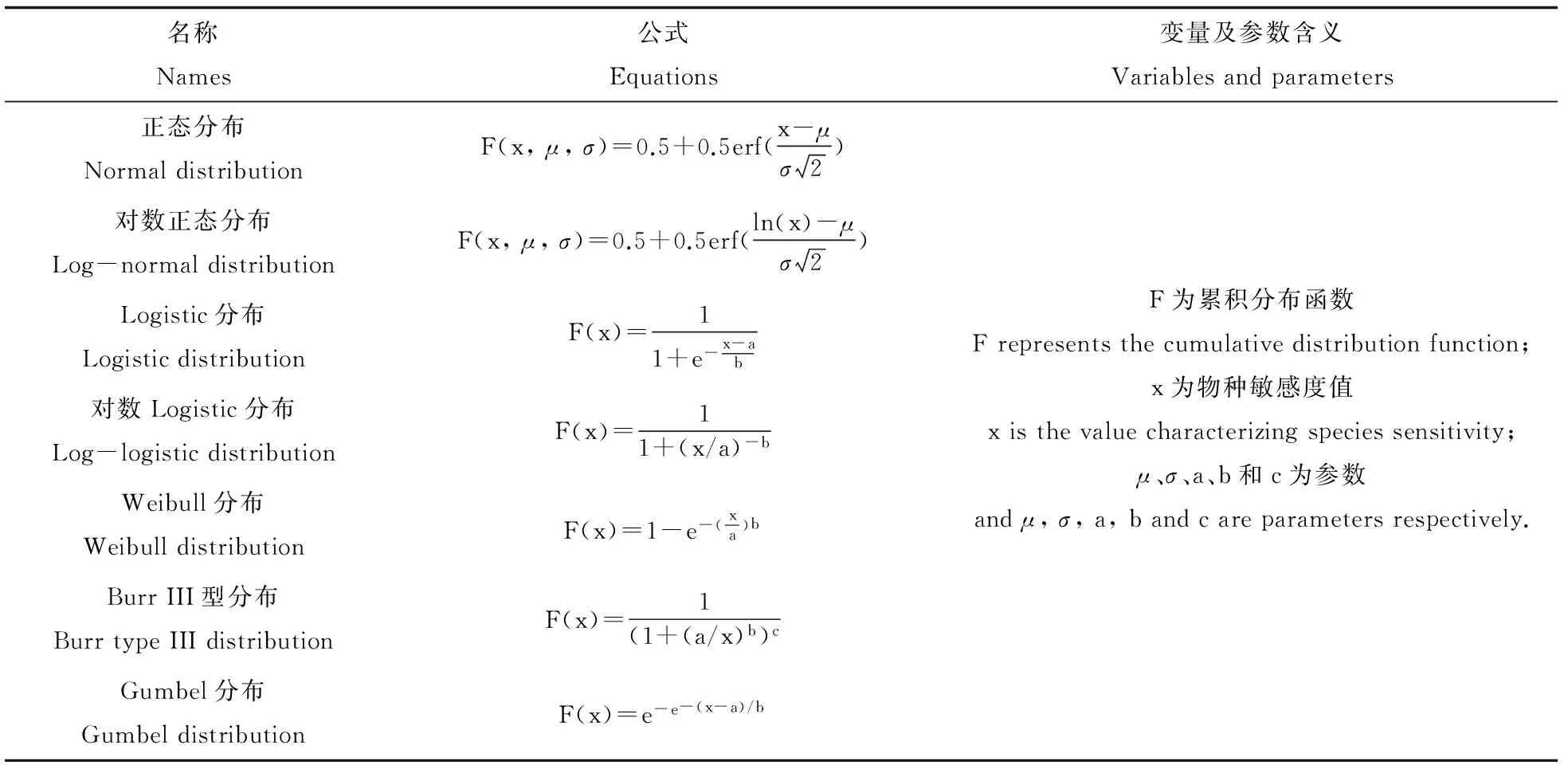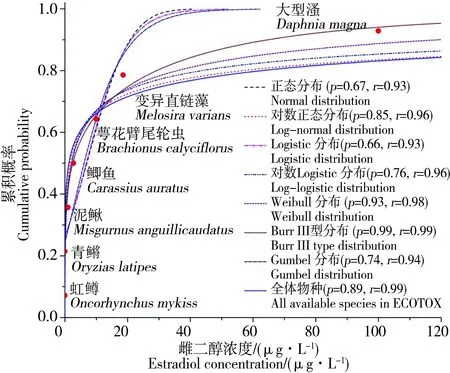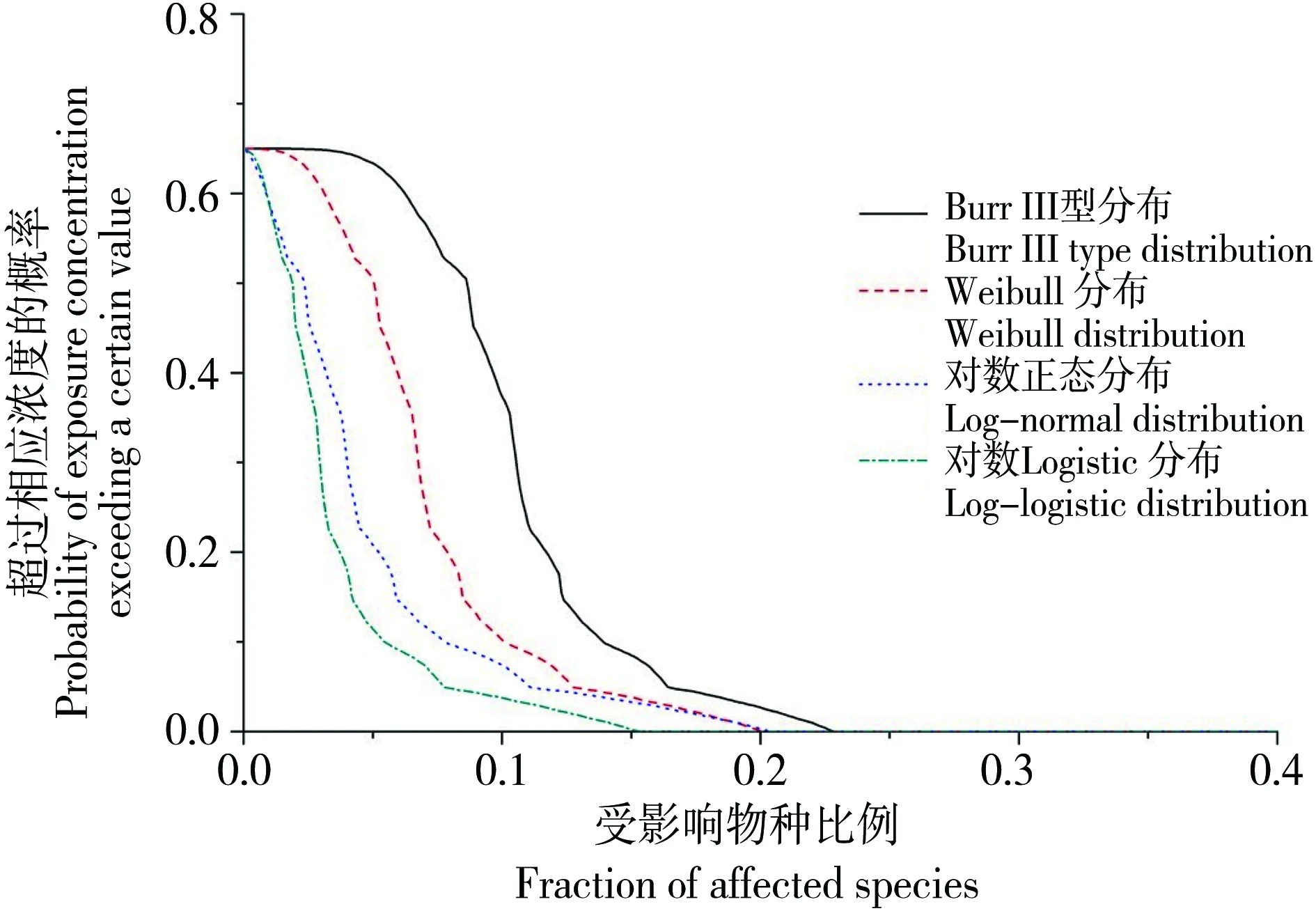北京市污水处理厂出水中雌二醇的概率生态风险评价
王铜,孙傅,曾思育,何苗
清华大学环境学院,北京 100084
北京市污水处理厂出水中雌二醇的概率生态风险评价
王铜,孙傅*,曾思育#,何苗
清华大学环境学院,北京 100084
随着北京市再生水补给河湖规模扩大,污水处理厂出水中雌激素活性物质引起的受纳水体生态风险日益受到关注。以雌二醇为例,利用物种敏感度分布(species sensitivity distribution,SSD)模型和联合概率曲线(joint probability curve,JPC)方法开展北京市污水处理厂出水的概率生态风险评价研究。通过文献调研整理了北京市约430个物种,利用美国环境保护署ECOTOX数据库获取了其中7个物种的雌二醇毒性数据,构建了正态分布、对数正态分布、Logistic分布、对数Logistic分布、Weibull分布、Burr III型分布和Gumbel分布等7个SSD模型,评价了北京市污水处理厂二沉池出水以及“混凝-沉淀-过滤-臭氧”、“超滤-臭氧”和“超滤-活性炭-臭氧”3种深度处理工艺组合出水的生态风险。结果表明,利用北京市7个物种雌二醇毒性数据构建的SSD模型具有合理性,SSD模型选择对生态风险评价结果的影响较大,对数正态分布、对数Logistic分布、Weibull分布和Burr III型均是可接受的SSD模型,其中拟合效果最佳的Burr III型分布模型给出了最保守的风险估计。Burr III型分布模型的模拟结果显示,北京市污水处理厂二沉池出水以及3种深度处理工艺组合出水的总体风险期望值分别为0.070、0.040、0.036和0.026,该结果可以为北京市未来水生态保护目标的设定以及污水处理工艺的升级改造提供决策参考。
雌二醇;本地物种;生态风险;污水处理厂;物种敏感度曲线;联合概率曲线
污水处理厂出水中的微量有毒有害化学物质及其生态影响日益受到关注,这些物质包括内分泌干扰物、药物及个人护理品、农药、多环芳烃等[1-6]。内分泌干扰物(包括雌激素类、雄激素类、类固醇抑制剂和甲状腺干扰物)因干扰生物体内荷尔蒙的合成、分泌、排泄等过程[7],一直是这一研究领域关注的一类重要物质[6,8-11],其中又以研究雌激素活性物质存在状况、危害及其生态风险的居多[12-20]。Desbrow等[12]和Routledge等[13]分别利用体外实验和体内试验发现,污水处理厂出水中的雌激素活性物质可能诱导受纳水体中雄性鱼类卵黄蛋白原的合成。在我国,Zha和Wang[16]研究了北京市北小河再生水厂不同处理工艺段出水对青鳉鱼的影响,发现二沉池、超滤及微滤出水在稀释一倍的情况下都会引起青鳉鱼性别比例的改变。
目前生态风险表征的方法主要包括商值法和概率法[21]。商值法比较危害物质的环境暴露浓度和预测无效应浓度(predicted no-effect concentration, PNEC),若二者比值大于1,则表明存在风险,商值越大,风险越高[22]。概率法通常利用物种敏感度分布(species sensitivity distribution, SSD)表征在不同暴露浓度危害物质的作用下受到不利影响物种的比例[21],在此基础上同时考虑危害物质暴露浓度的不确定性,例如安全阈值(margin of safety)方法和联合概率曲线(joint probability curve, JPC)方法[22-23]。商值法通常基于最敏感物种的毒性数据计算PNEC,因而评价结果偏于保守,并且其计算结果只能指示风险是否存在及其相对高低,而不能表征生态系统中物种受到不利影响的范围和程度,因此适用于生态风险的筛查或初步评价[21]。概率法可以建立危害物质浓度与受影响物种比例之间的定量关系,因此其生态含义和管理意义更加明确(如建立有毒有害物质的环境基准)[23]。虽然具有这些优势,概率法的应用在很大程度上依赖于危害物质对不同物种的毒性效应数据的可获得性,并且物种选择应能体现地域差异。由于对本地物种的相关毒性试验和研究相对缺乏[24],我国目前利用概率法开展有毒有害物质生态风险评价的研究通常借鉴国外相关研究成果和数据库构建SSD,较少考虑我国和其他国家或地区在物种分布方面的地域差异,因此风险评价结果对本地的适用性需要进一步考察[24]。同时,在概率生态风险评价中,SSD模型的选择也会直接影响评价结果。虽然一些学者和指南文件推荐了可供选择的SSD模型(如对数正态分布和Weibull分布),但目前尚不能找到一种适用于所用情况的模型[25-27]。现有研究通常是根据经验直接选择某一种模型,很少考虑SSD模型选择的偶然性或不确定性对风险评价结果的影响。
目前,北京市使用污水处理厂出水(含再生水)补给的河道比例已达70%以上[28],其中有毒有害物质的生态风险日益引起关注[2,4-6,10]。作为雌激素活性物质的一种,雌二醇常被用作雌激素活性的当量物质,用来表征此类物质对生态系统的影响[29],而污水处理厂出水是受纳水体雌二醇的重要来源之一[30-31]。因此,本文以评价北京市污水处理厂出水中雌二醇的生态风险为目标,构建基于北京市本地物种的SSD模型,在此基础上考察污水处理厂出水中雌二醇的浓度分布、不同SSD模型以及不同深度处理工艺对受纳水体生态风险的影响,以期为北京市再生水补给河湖的生态风险评价和管理提供方法基础。
1 方法(Methods)
1.1 生态风险评价方法
1.1.1 SSD模型的选择
基于文献调研[25-27],本文选取国内外相关技术导则和现有研究推荐或常用7种SSD模型,列于表1中。本文对表中7种SSD模型开展对比研究,一方面是为了获得与物种毒性效应数据吻合最好的模型,从而获得最佳的生态风险估计,另一方面是为了考察SSD模型选择对生态风险评价结果不确定性的影响。
1.1.2 JPC方法的应用
当SSD模型和危害物质的暴露浓度确定后,受影响的物种比例(fraction affected, FA)即为定值。因此,当暴露浓度存在不确定性时,这种不确定性也会传递到FA。本文利用JPC表征污水处理厂出水中雌二醇浓度的不确定性对生态风险评价结果的影响。JPC通过结合SSD模型和危害物质的暴露浓度分布得到,其横坐标为一系列暴露浓度水平下受影响物种的比例,纵坐标为暴露浓度分布中超过相应浓度水平的概率。JPC越接近两侧坐标轴,其表征的生态风险越低[32-34]。除此之外,JPC与两侧坐标轴构成区域的面积可以表征总体风险的期望值(expected total risk, ETR)[23],如式1所示
(1)
式中,x表示毒性物质浓度,CDFX1和CDFX2分别表示毒性物质浓度的累积概率分布和毒性物质的SSD。
1.2 数据来源
1.2.1 毒性数据
本文的研究区域为北京市,为了构建基于北京市本地物种的SSD模型,经过文献调研,获取了北京市以及水系直接关联的河北和天津部分区域存在物种约430个[35-44],并在美国环境保护署(EPA)的ECOTOX数据库(http://www.epa.gov/ecotox/)中查询雌二醇对这些物种的毒性数据。经过筛选,共获得7个物种的雌二醇毒性数据,包括:萼花臂尾轮虫(Brachionuscaly ciflorus)、鲫鱼(Carassius auratus)、大型溞(Daphnia magna)、变异直链藻(Melosira varians)、泥鳅(Misgurnus anguillicaudatus)、虹鳟(Oncorhynchus mykiss)和青鳉(Oryzias latipes)。经检验,本文获取的数据满足《澳大利亚和新西兰淡水和海水水质准则》[25]提出的建立SSD模型的要求,即包括至少4种不同生物分类的至少5个物种的慢性无观测效应浓度(no-observed-effect concentration, NOEC)值。根据该准则的要求,对上述获取的

表1 选取的7种SSD模型
毒性数据进行进一步处理,规则如下:(1)对于同一物种不同效应的NOEC值,选取最低值;(2)对于同一物种相同效应的NOEC值,取几何平均值。
将经过上述处理的7个物种的NOEC值由小到大排序,利用Hazen公式[23]计算每个数据点的累积概率,见式(2)。
(2)
式中, yi为第i个数据点的累积概率,i为每个物种NOEC从小到大排列的秩,n为数据点数量。
将7组NOEC和 yi带入表1所示的SSD模型公式中进行拟合,获得参数值。本研究通过Kolmogorov-Smirnov(K-S)检验的p值和曲线拟合的相关系数r值来判断SSD模型与毒性数据的吻合程度。
由于本文从ECOTOX数据库中仅获取了与北京市7个物种相关的雌二醇毒性数据,数据量偏少,为了考察其合理性和代表性,本文同时使用数据库中可获得的全体30个物种的雌二醇NOEC数据构建SSD模型,并与基于北京市物种构建的SSD模型相比较。
1.2.2 暴露数据
为了研究北京市污水处理厂出水中雌二醇对受纳水体的生态风险以及不同深度处理工艺对削减这一风险的影响,本文通过文献调研获取了北京市污水处理厂二沉池出水中雌二醇的浓度以及典型深度处理工艺单元(包括混凝-沉淀、砂滤、超滤、活性炭、臭氧等)对雌二醇的去除率等数据[30,45-56],其中二沉池出水中雌二醇浓度数据为41个,混凝-沉淀、砂滤、超滤、活性炭和臭氧等工艺去除率的数据量为10~13个。在此基础上,参照北京市再生水厂的深度处理工艺,构造以下4种工艺组合:(A)无深度处理;(B)混凝-沉淀-过滤-臭氧;(C)超滤-臭氧;(D)超滤-活性炭-臭氧。为了考虑二沉池出水浓度以及各工艺单元去除效率的不确定性,本文在其经验分布的基础上进行50 000次Monte Carlo模拟,得到不同工艺组合出水中雌二醇的浓度分布,由此利用上述SSD模型,推导不同工艺组合下的JPC。
1.3 数据处理
SSD模型的拟合和验证、不同工艺组合下出水中雌二醇浓度分布的Monte Carlo模拟、JPC的推导以及ETR的计算均使用Matlab软件完成。
2 结果(Results)
2.1 SSD模型
本文从美国EPA的ECOTOX数据库中获取了雌二醇对北京市7个物种全部毒性效应终点的NOEC值,对于每个物种不同效应终点选取最低的NOEC值表征其对雌二醇的敏感度。毒性数据较多的是虹鳟(Oncorhynchus mykiss)和青鳉(Oryzias latipes),毒性效应终点包括对卵黄蛋白原、繁殖能力、生长的影响等。最敏感的物种为虹鳟(Oncorhynchus mykiss),其NOEC值最低的毒性效应终点为对繁殖能力的影响,这与文献中报道的鱼类生殖系统对雌激素类物质最为敏感相一致[34, 57-59]。青鳉(Oryzias latipes)NOEC值最低的毒性效应终点为对生长长度的影响;泥鳅(Misgurnus anguillicaudatus)最低NOEC值对应的毒性效应终点为对体内生化指标(钙、镁和蛋白质含量)的影响;鲫鱼(Carassius auratus)只有一个可用的NOEC值,为对体内荧光素酶的影响;大型溞(Daphnia magna)NOEC值最低的毒性效应终点为存活率和形态变化;变异直链藻(Melosira varians)最低NOEC值对应的毒性效应终点为叶绿素a的比例;萼花臂尾轮虫(Brachionuscaly ciflorus)只有一个有效的NOEC数据,其毒性效应终点为对受精的影响。总体来看,营养等级高的鱼类对雌二醇比较敏感,萼花臂尾轮虫(Brachionuscaly ciflorus)、变异直链藻(Melosira varians)和大型溞(Daphnia magna)的耐受性较高。
雌二醇对北京市7个物种的毒性数据以及表1中7种SSD模型对这些数据的拟合结果如图1所示,每种SSD模型的K-S检验p值和曲线拟合相关系数r也列在图中。从图中可以看出,7种SSD模型的K-S检验p值均大于0.05,且拟合相关系数r均大于0.9,总体上能够较好地模拟北京市7个物种对雌二醇毒性的响应关系。进一步观察7种SSD模型可以看出,正态分布、Logistic分布和Gumbel分布3种SSD模型的模拟效果略差,并且其累积概率在雌二醇浓度为40 μg·L-1时已接近1,过高地估计了雌二醇的毒性效应。故在下文的生态风险评价中,仅选取拟合效果较好的对数正态分布、对数Logistic分布、Weibull分布和Burr III型分布4种SSD模型。同时,通过拟合相关系数比较以及图形直观比较可以发现,这4种SSD模型中Burr III型分布的拟合效果最好。
本文还利用ECOTOX数据库中可获得的全体30个物种的雌二醇NOEC数据建立了SSD模型,对表1中7种SSD模型的拟合结果比较后发现,Weibull分布的拟合效果最好,这一结果亦列于图1中。

图1 基于北京市物种和ECOTOX数据库中全体物种的雌二醇SSD模型Fig. 1 SSDs models based on Beijing native species and all available species in the ECOTOX database
2.2 污水处理厂出水的雌二醇浓度分布
图2对比了4种不同深度处理工艺组合出水的雌二醇浓度分布。工艺组合A为无深度处理工艺时即二沉池出水的雌二醇浓度分布,其均值为2.2 ng·L-1,中位值为0.35 ng·L-1,均低于孙艳等[7]报道的结果,这可能与二者统计范围不同有关,本文主要关注北京市污水处理厂的相关数据。同时,从图2可以看出,3种深度处理工艺组合对雌二醇去除效率的高低依次是:超滤-活性炭-臭氧(工艺组合D)>超滤-臭氧(工艺组合C)>混凝-沉淀-过滤-臭氧(工艺组合B),这与预期结果是一致的。以中位值来看,

图2 北京市污水处理厂不同深度处理工艺组合出水的雌二醇浓度分布Fig. 2 Cumulative distribution of estradiol concentration in the effluents from different advanced treatment processes in Beijing
工艺组合D、C和B对雌二醇的去除率均可达98%以上,而以第95百分位数来看,三者的去除率分别为85.5%、92.3%和98.5%。
2.3 污水处理厂出水中雌二醇的生态风险
利用图2中工艺组合A出水雌二醇浓度的概率分布和图1中4种不同SSD模型可以推导得到不同工艺组合的JPC。图3所示为无深度处理工艺时北京市污水处理厂二沉池出水中雌二醇的生态风险。以横坐标取值0.05为例,从图3可以看出Burr III型分布对应的纵坐标取值约为0.63,这表明北京市污水处理厂二沉池出水中雌二醇造成受纳水体5%的物种受到不利影响的概率为63%。相应地,根据Weibull分布、对数正态分布和对数Logistic分布模型得到的概率分别为51%、21%和11%。如前所述,JPC越接近两侧坐标值,其生态风险越低,因此4种SSD模型计算得到的生态风险由高到低依次是:Burr III型分布>Weibull分布>对数正态分布>对数Logistic分布,其相应的ETR分别为0.070、0.047、0.032和0.023。
表2给出了北京市污水处理厂不同深度处理工艺组合出水中雌二醇的ETR。与未采用深度处理工艺即工艺组合A相比,其他3种工艺组合均能显著降低出水雌二醇的生态风险,但根据不同SSD模型计算得到的ETR存在较大差异。
3 讨论(Discussion)
3.1 物种选择对于SSD模型的影响
对比图1中基于北京市物种和ECOTOX数据库中全体物种构建的雌二醇SSD模型可以看出,在低浓度段时后者的累积概率高于前者,在高浓度段时则相反。这是因为ECOTOX数据库涵盖的物种丰富,NOEC的跨度较大(0.00027~1361.9 μg·L-1),故在低浓度段和高浓度段均有充足的数据点,而北京市7个物种的NOEC则相对集中(0.00042~100 μg·L-1)。北京市7个物种NOEC的最小值(0.00042 μg·L-1,y1=0.07)、中位数(2.72 μg·L-1,y4=0.50)和最大值(100 μg·L-1,y7=0.93)在全体30个物种NOEC值中对应的累积概率分别为0.07、0.57和0.90,由此可见二者的概率分布具有较好的相似性。因此,虽然本文从ECOTOX数据库中仅获取到北京市7个物种的雌二醇毒性数据,但是这7个物种具有较好的代表性,由此建立SSD模型开展生态风险评价具有合理性。

图3 基于不同SSD模型的北京市污水处理厂二沉池出水中雌二醇的生态风险Fig. 3 Estimated ecological risk of estradiol in the effluents of secondary sedimentation tanks from wastewater treatment plants in Beijing based on different SSD models

表2 北京市污水处理厂不同深度处理工艺组合出水中雌二醇的生态风险
制定水环境质量基准时,通常以造成5%物种损害的浓度值作为参考,即HC5(hazardous concentration for 5% of the species),通过安全因子,计算得到PNEC值。本文采用的毒性数据为慢性NOEC值,具有较高的可信度,故采用其HC5作为PNEC值[25]。根据图1中不同的SSD模型可以得到,基于北京市物种的对数正态分布、对数Logistic分布、Weibull分布和Burr III型分布4种模型的PNEC值分别为1.49×10-3、3.19×10-3、3.35×10-4和2.20×10-5μg·L-1。Young等[59]以青鳉鱼早期生命阶段雌化现象为效应终点推导得到雌二醇的PNEC值为1 ng·L-1,Kramer等[60]采用黑头呆鱼产卵量为效应终点获得的PNEC值为6.6 ng·L-1,Caldwell等[58]采用鱼类繁殖能力为效应终点获得的PNEC值为2 ng·L-1。本文4种SSD模型推导得到的雌二醇PNEC值与这些文献值基本可比或低于文献值,这可能与物种和毒性效应终点选择的差异有关。这些文献中的PNEC值是基于单一或多个鱼类物种的某一类与生殖系统相关的毒性效应终点得到的,而本文考虑水生生态系统的整体影响,对多个营养级的物种选取最敏感的毒性效应终点。根据图1还可以得到基于全体物种的PNEC值为7.46×10-6μg·L-1,较基于北京市物种得到的结果低1~2个数量级。这意味着,在制定雌二醇水环境质量标准时,如果不考虑北京市物种特点而直接采用ECOTOX数据库全体物种的毒性数据,有可能导致标准过于严格,造成“过保护”和资源浪费。
3.2 SSD模型选择对生态风险的影响
从图3和表2可以看出,SSD模型选择对雌二醇生态风险评价结果的影响很大,对于同一工艺组合,采用Burr III型分布和对数Logistic分布模型得到的ETR可相差3~9倍。从表2还可以看出,使用对数Logistic分布模型得到的二沉池出水的ETR(0.023)低于使用Burr III型分布模型得到的工艺组合D的ETR(0.026),说明SSD模型选择对ETR的影响甚至超过处理工艺组合的影响。因此,在开展生态风险评价时,应充分考虑SSD模型选择带来的不确定性,仅仅依靠经验或参照其他研究直接选择一种SSD模型,可能会导致生态风险评价结果出现系统偏差。需要指出的是,本文中拟合效果最佳的Burr III型分布模型恰好具有最保守的风险估计,因此以此为基础的风险管理是偏于安全的。
3.3 深度处理工艺的选择
本文的生态风险评价结果可以为北京市未来污水处理系统升级改造的工艺选择提供参考。从表2可以看出,北京市污水处理厂二沉池出水经过3种不同的深度处理工艺组合后,出水中雌二醇的生态风险均有显著下降。以最保守的Burr III型分布模型为例,如果北京市以保护95%的物种为目标,那么未经深度处理的二沉池出水不能达到这一保护目标,而增加深度处理工艺组合B、C或D之后均可满足这一目标。若将保护目标提升为保护99%的物种,那么本文所研究的工艺组合B、C和D均无法达到,需要引入更加高效的处理工艺。
综上所述,考虑SSD模型的不确定性,目前北京市污水处理厂二沉池出水中雌二醇的总体生态风险期望值为0.023~0.070,即约2.3%~7.0%的水生生物物种可能受到不利影响,总体处于较低水平。经过不同深度处理工艺后,雌二醇的总体生态风险期望值可降至0.04以下,满足国际上通常采用的保护95%物种的生态管理要求。研究还发现,利用SSD模型开展概率生态风险评价时,物种选择和SSD模型选择对生态风险评价结果的不确定性会产生重要影响。因此,在数据可获得的情况下,应尽可能选择本地物种的毒性数据构建SSD模型,同时对多种SSD模型进行综合比选,从而提高生态风险评价结果的可靠性。随着北京市再生水补给河湖利用规模的迅速扩大,应加强其生态风险研究,建立本地物种毒性测试和评价方法以及相应的毒性数据库,从而降低毒性数据稀缺带来的SSD模型的不确定性,为确定经济合理、技术可达的生态保护水平提供决策依据。此外,本文的研究对象是污水处理厂出水中的雌二醇,但水生生物直接暴露的应是水环境中的雌二醇,所以后续应进一步研究水环境中雌二醇的存在状况以及污水处理厂出水中的雌二醇在水环境中的迁移转化规律,修正本文的相关研究结果。
[1] Peng X Z, Yu Y Y, Tang C M, et al. Occurrence of steroid estrogens, endocrine-disrupting phenols, and acid pharmaceutical residues in urban riverine water of the Pearl River Delta, South China [J]. Science of the Total Environment, 2008, 397(1-3): 158-166
[2] Sun Q F, Deng S B, Huang J, et al. Contributors to estrogenic activity in wastewater from a large wastewater treatment plant in Beijing, China [J]. Environmental Toxicology and Pharmacology, 2008, 25(1): 20-26
[3] Zhao J L, Ying G G, Wang L, et al. Determination of phenolic endocrine disrupting chemicals and acidic pharmaceuticals in surface water of the Pearl Rivers in South China by gas chromatography-negative chemical ionization-mass spectrometry [J]. Science of the Total Environment, 2009, 407(2): 962-974
[4] Sui Q, Huang J, Deng S B, et al. Occurrence and removal of pharmaceuticals, caffeine and DEET in wastewater treatment plants of Beijing, China [J]. Water Research, 2010, 44(2): 417-426
[5] Sui Q, Huang J, Deng S B, et al. Seasonal variation in the occurrence and removal of pharmaceuticals and personal care products in different biological wastewater treatment processes [J]. Environmental Science & Technology, 2011, 45(8): 3341-3348
[6] Chang H, Wan Y, Wu S M, et al. Occurrence of androgens and progestogens in wastewater treatment plants and receiving river waters: Comparison to estrogens [J]. Water Research, 2011, 45(2): 732-740
[7] 孙艳, 黄璜, 胡洪营, 等. 污水处理厂出水中雌激素活性物质浓度与生态风险水平[J]. 环境科学研究, 2010, 23(12): 1488-1493
Sun Y, Huang H, Hu H Y, et al. Concentration and ecological risk level of estrogenic endocrine-disrupting chemicals in the effluents from wastewater treatment plants [J]. Research of Environmental Sciences, 2010, 23(12): 1488-1493 (in Chinese)
[8] Wang Y Q, Hu W, Cao Z H, et al. Occurrence of endocrine-disrupting compounds in reclaimed water from Tianjin, China [J]. Analytical and Bioanalytical Chemistry, 2005, 383(5): 857-863
[9] Fan Z L, Wu S M, Chang H, et al. Behaviors of glucocorticoids, androgens and progestogens in a municipal sewage treatment plant: Comparison to estrogens [J]. Environmental Science & Technology, 2011, 45(7): 2725-2733
[10] Li N, Ma M, Rao K F, et al. In vitro thyroid disrupting effects of organic extracts from WWTPs in Beijing [J]. Journal of Environmental Sciences, 2011, 23(4): 671-675
[11] Rao K F, Li N, Ma M, et al. In vitro agonistic and antagonistic endocrine disrupting effects of organic extracts from waste water of different treatment processes [J]. Frontiers of Environmental Science & Engineering, 2014, 8(1): 69-78
[12] Desbrow C, Routledge E J, Brighty G C, et al. Identification of estrogenic chemicals in STW effluent. 1. Chemical fractionation and in vitro biological screening [J]. Environmental Science & Technology, 1998, 32(11): 1549-1558
[13] Routledge E J, Sheahan D, Desbrow C, et al. Identification of estrogenic chemicals in STW effluent. 2. In vivo responses in trout and roach [J]. Environmental Science & Technology, 1998, 32(11): 1559-1565
[14] Welshons W V, Thayer K A, Judy B M, et al. Large effects from small exposures. I. Mechanisms for endocrine-disrupting chemicals with estrogenic activity [J]. Environmental Health Perspectives, 2003, 111(8): 994-1006
[15] Vom Saal F S, Hughes C. An extensive new literature concerning low-dose effects of bisphenol A shows the need for a new risk assessment [J]. Environmental Health Perspectives, 2005, 113(8): 926-933
[16] Zha J M, Wang Z J. Assessing technological feasibility for wastewater reclamation based on early life stage toxicity of Japanese medaka(Oryzias latipes) [J]. Agriculture, Ecosystems & Environment, 2005, 107(2-3): 187-198
[17] Zha J M, Wang Z J. Acute and early life stage toxicity of industrial effluent on Japanese medaka (Oryziaslatipes) [J]. Science of the Total Environment, 2006, 357(1-3): 112-119
[18] Zha J M, Sun L W, Zhou Y Q, et al. Assessment of 17α-ethinylestradiol effects and underlying mechanisms in a continuous, multigeneration exposure of the Chinese rare minnow (Gobiocypris rarus) [J]. Toxicology and Applied Pharmacology, 2008, 226(3): 298-308
[19] Jukosky J A, Watzin M C, Leiter J C. The effects of environmentally relevant mixtures of estrogens on Japanese medaka (Oryzias latipes) reproduction [J]. Aquatic Toxicology, 2008, 86(2): 323-331
[20] Waiser M J, Humphries D, Tumber V, et al. Effluent-dominated streams. Part 2: Presence and possible effects of pharmaceuticals and personal care products in Wascana Creek, Saskatchewan, Canada [J]. Environmental Toxicology and Chemistry, 2011, 30(2): 508-519
[21] 雷炳莉, 黄圣彪, 王子健. 生态风险评价理论和方法[J]. 化学进展, 2009, 21(2/3): 350-358
Lei B L, Huang S B, Wang Z J. Theories and methods of ecological risk assessment [J]. Progress in Chemistry, 2009, 21(2/3): 350-358 (in Chinese)
[22] 郭广慧, 吴丰昌, 何宏平, 等. 太湖梅梁湾、贡湖湾和胥口湾水体PAHs的生态风险评价[J]. 环境科学学报, 2011, 31(12): 2804-2813
Guo G H, Wu F C, He H P, et al. Ecological risk assessment of PAHs in the Meiliang Bay, Gonghu Bay, and Xukou Bay of Taihu Lake [J]. Acta Scientiae Circumstantiae, 2011, 31(12): 2804-2813 (in Chinese)
[23] Aldenberg T, Jaworska J S, Traas T P. Normal species sensitivity distributions and probabilistic ecological risk assessment [M]// Species Sensitivity Distributions in Ecotoxicology. Boca Raton, USA: Lewis Publishers, 2002: 49-102
[24] 金小伟, 王业耀, 王子健. 淡水水生态基准方法学研究: 数据筛选与模型计算[J]. 生态毒理学报, 2014, 9(1): 1-13
Jin X W, Wang Y Y, Wang Z J. Methodologies for deriving aquatic life criteria (ALC): Data screening and model calculation [J]. Asian Journal of Ecotoxicology, 2014, 9(1): 1-13 (in Chinese)
[25] ANZECC (Australian and New Zealand Environment and Conservation Council), ARMCANZ (Agriculture and Resource Management Council of Australia and New Zealand). Australian and New Zealand guidelines for fresh and marine water quality.Volume 2 [R]. Canberra: ANZECC and ARMCANZ, 2000
[26] Wheeler J R, Grist E P M, Leung K M Y, et al. Species sensitivity distributions: Data and model choice [J]. Marine Pollution Bulletin, 2002, 45(1): 192-202
[27] CCME(Canadian Council of Ministers of the Environment). A protocol for the derivation of water quality guidelines for the protection of aquatic life 2007 [R]. Winnipeg: CCME, 2007
[28] 北京市发展和改革委员会. 近年来北京市用水量变化情况[EB/OL]. (2009-12-16) [2014-04-22]. http://www.bjpc.gov.cn/zt/09shui/xgqk/200912/t510940.htm
[29] Falconer I R, Chapman H F, Moore M R, et al. Endocrine-disrupting compounds: A review of their challenge to sustainable and safe water supply and water reuse [J]. Environmental Toxicology, 2006, 21(2): 181-191
[30] 曹仲宏, 马永民, 胡伟, 等. 再生水中内分泌干扰物的初步研究[J]. 环境与健康杂志, 2005, 22(3): 171-173
Cao Z H, Ma Y M, Hu W, et al. Endocrine disrupting compounds in reclaimed water produced by a certain water plant: Some preliminary results [J]. Journal of Environment and Health, 2005, 22(3): 171-173 (in Chinese)
[31] 黄深. 城市污水厂二级处理出水臭氧深度处理研究[D]. 北京: 清华大学, 2008
Huang S. Advanced treatment of secondary effluent by ozonation [D]. Beijing: Tsinghua University, 2008 (in Chinese)
[32] Solomon K, Giesy J, Jones P. Probabilistic risk assessment of agrochemicals in the environment [J]. Crop Protection, 2000, 19(8): 649-655
[33] Wang Z, Wang Y, Ma X D, et al. Probabilistic ecological risk assessment of typical PAHs in coastal water of Bohai Sea [J]. Polycyclic Aromatic Compounds, 2013, 33(4): 367-379
[34] Jin X W, Wang Y Y, Jin W, et al. Ecological risk of nonylphenol in China surface waters based on reproductive fitness [J]. Environmental Science & Technology, 2014, 48(2): 1256-1262
[35] 王宏伟, 昌艳萍, 张磊, 等. 拒马河原生动物和底栖动物初步调查及水质分析[J]. 动物学杂志, 2006, 41(4): 77-82
Wang H W, Chang Y P, Zhang L, et al. Primary survey on protozoa and benthos and assessment of water quality in Juma River [J]. Chinese Journal of Zoology, 2006, 41(4): 77-82 (in Chinese)
[36] 任淑智. 北京小型湖泊底栖无脊椎动物群落结构特征与营养状况的研究[J]. 应用生态学报, 1991, 2(3): 221-225
Ren S Z. Community structure of macroinvertebrates and trophic level of several small lakes in Beijing city [J]. Chinese Journal of Applied Ecology, 1991, 2(3): 221-225 (in Chinese)
[37] 许木启. 京密运河-北京排污河浮游动物群落变化与水质关系的研究[J]. 环境科学学报, 1993, 13(3): 347-354
Xu M Q. Relationship between change in zooplankton community and water quality of Jingmi Canal and Beijing sewage stream [J]. Acta Scientiae Circumstantiae, 1993, 13(3): 347-354 (in Chinese)
[38] 王鸿媛, 北京鱼类和两栖. 爬行动物志[M]. 北京: 北京出版社, 1994
[39] 杨文波, 李继龙, 李绪兴, 等. 拒马河北京段鱼类组成及其多样性[J]. 上海水产大学学报, 2008, 17(2): 175-181
Yang W B, Li J L, Li X X, et al. Fish composition and species biodiversity of the Beijing section of Juma River [J]. Journal of Shanghai Fisheries University, 2008, 17(2): 175-181 (in Chinese)
[40] 卫新锋, 赵彦伟, 彭可扬, 等. 北京市五景观湖泊浮游藻类评价及聚类分析[J]. 水土保持研究, 2009, 16(2): 212-215
Wei X F, Zhao Y W, Peng K Y, et al. Phytoplankton evaluation and cluster analysis of 5 landscape-lakes in Beijing [J]. Research of Soil and Water Conservation, 2009, 16(2): 212-215 (in Chinese)
[41] 李竹, 杨定, 李枢强. 北京地区常见昆虫和其他无脊椎动物[M]. 北京: 北京科学技术出版社, 2011
[42] 李永刚. 密云水库浮游生物底栖动物群落结构及生物多样性研究[D]. 北京: 中国农业科学院研究生院, 2012
Li Y G. Studies of the community structure and biodiversity of plankton and zoobenthos in Miyun Reservoir [D]. Beijing: Graduate School of Chinese Academy of Agricultural Sciences, 2012 (in Chinese)
[43] 高彩凤. 北运河水系水生态调查及水质评价[D]. 河南: 河南师范大学, 2012
Gao C F. Investigation of aquatic ecosystem and water quality evaluation in Beiyunhe River [D]. Henan: Henan Normal University, 2012 (in Chinese)
[44] 张春光, 赵亚辉. 北京及其邻近地区的鱼类: 物种多样性、资源评价和原色图谱[M]. 北京: 科学出版社, 2013
Zhang C G, Zhao Y H. Fishes in Beijing and adjacent areas, China [M]. Beijing: Science Press, 2013(in Chinese)
[45] Deborde M, Rabouan S, Duguet J P, et al. Kinetics of aqueous ozone-induced oxidation of some endocrine disruptors [J]. Environmental Science & Technology, 2005, 39(16): 6086-6092
[46] Westerhoff P, Yoon Y, Snyder S A, et al. Fate of endocrine-disruptor, pharmaceutical, and personal care product chemicals during simulated drinking water treatment processes [J]. Environmental Science & Technology, 2005, 39(17): 6649-6663
[47] Huber M M, Gobel A, Joss A, et al. Oxidation of pharmaceuticals during ozonation of municipal wastewater effluents: A pilot study [J]. Environmental Science & Technology, 2005, 39(11): 4290-4299
[48] 王淑娟. 典型水处理过程中有毒有机物质的污染与去除[D]. 北京: 北京林业大学, 2006
Wang S J. Study on the pollution and removal of toxic organic pollutants in typical water treatment process [D]. Beijing: Beijing Forestry University, 2006 (in Chinese)
[49] Hashimoto T, Takahashi K, Murakami T. Characteristics of estrogen decomposition by ozonation [J]. Water Science & Technology, 2006, 54(10): 87-93
[50] Snyder S A, Adham S, Redding A M, et al. Role of membranes and activated carbon in the removal of endocrine disruptors and pharmaceuticals [J]. Desalination, 2007, 202(1): 156-181
[51] 周益奇. 北京市不同水体中内分泌干扰物质的来源和归属[D]. 北京: 中国科学院研究生院, 2008
Zhou Y Q. Source and fate of endocrine disrupting compounds in different water body in Beijing, China [D]. Beijing: Graduate School of the Chinese Academy of Sciences, 2008 (in Chinese)
[52] Broseus R, Vincent S, Aboulfadl K, et al. Ozone oxidation of pharmaceuticals, endocrine disruptors and pesticides during drinking water treatment [J]. Water Research, 2009, 43(18): 4707-4717
[53] Yoon Y, Westerhoff P, Snyder S A, et al. HPLC-fluorescence detection and adsorption of bisphenol A, 17β-estradiol, and 17α-ethynyl estradiol on powdered activated carbon [J]. Water Research, 2003, 37(14): 3530-3537
[54] Yoon Y, Westerhoff P, Snyder S A, et al. Removal of endocrine disrupting compounds and pharmaceuticals by nanofiltration and ultrafiltration membranes [J]. Desalination, 2007, 202(1): 16-23
[55] Zhou H D, Huang X, Wang X L, et al. Behaviour of selected endocrine-disrupting chemicals in three sewage treatment plants of Beijing, China [J]. Environmental Monitoring and Assessment, 2010, 161(1-4): 107-121
[56] Zhou Y Q, Zha J M, Wang Z J. Occurrence and fate of steroid estrogens in the largest wastewater treatment plant in Beijing, China [J]. Environmental Monitoring and Assessment, 2012, 184(11): 6799-6813
[57] Caldwell D J, Mastrocco F, Hutchinson T H, et al. Derivation of an aquatic predicted no-effect concentration for the synthetic hormone, 17α-ethinyl estradiol [J]. Environmental Science & Technology, 2008, 42(19): 7046-7054
[58] Caldwell D J, Mastrocco F, Anderson P D, et al. Predicted-no-effect concentration for the steroid estrogens estrone, 17β-estradiol, estriol, and 17α-ethinylestradiol [J]. Environmental Toxicology and Chemistry, 2012, 31(6): 1396-1406
[59] Young W F, Whitehouse P, Johnson I, et al. Proposed predicted-no-effect-concentrations (PNECs) for natural and synthetic steroid oestrogens in surface waters [R]. Bristol: Environmental Agency R&D Dissemination Centre, 2004
[60] Kramer V J, Miles-Richardson S, Pierens S L, et al. Reproductive impairment and induction of alkaline-labile phosphate, a biomarker of estrogen exposure, in fathead minnows (Pimephales promelas) exposed to waterborne 17β-estradiol [J]. Aquatic Toxicology, 1998, 40(4): 335-360
◆
Probabilistic Ecological Risk Assessment of Estradiol in the Effluents of Wastewater Treatment Plants in Beijing
Wang Tong, Sun Fu*, Zeng Siyu#, He Miao
School of Environment,Tsinghua University, Beijing 100084, China
23 April 2014 accepted 13 May 2014
With the augmentation of rivers and lakes using reclaimed wastewater expanding in Beijing, there have been growing concerns about the ecological risk caused by estrogenic endocrine-disrupting chemicals in the effluents of wastewater treatment plants (WTPs). The ecological risk of estradiol, as an example, in WTPs' effluents was assessed with species sensitivity distribution (SSD) models and joint probability curves (JPCs). About 430 native species in Beijing were collected through literature review, among which 7 species found their toxicity data associated with estradiol in the ECOTOX database developed by US EPA. Seven SSD models were established to fit the available toxicity data including Normal distribution, Log-normal distribution, Logistic distribution, Log-logistic distribution, Weibull distribution, Burr Type III distribution and Gumbel distribution, and then the validated SSD models were applied to assess the ecological risk of estradiol caused by the effluents of secondary sedimentation tanks and 3 advanced treatment processes, i.e. coagulation-sedimentation-filtration-O3, ultrafiltration-O3, and ultrafiltration-activated carbon-O3, from typical WTPs in Beijing. The SSD models based on the toxicity data of estradiol with respect to the 7 native species of Beijing could be reasonably interpreted, and different types of SSD models had significant impact on the results of ecological risk assessment. Log-normal distribution, Log-logistic distribution, Weibull distribution and Burr Type III distribution were acceptable SSD models, and the best fitted model, Burr Type III distribution, gave the most conservative risk estimates. With Burr Type III distribution model, expected total risk of estradiol from the effluents of secondary sedimentation tanks and 3 advanced treatment processes was estimated to be 0.070, 0.040, 0.036 and 0.026, respectively. The results could support future decision-making when defining protection goals of aquatic ecosystems and upgrading and retrofitting wastewater treatment processes in Beijing.
estradiol; native species; ecological risk; wastewater treatment plant; species sensitivity distribution; joint probability curve
国家水体污染控制与治理科技重大专项(2009ZX07318-001-02)
王铜(1989-),女,硕士,研究方向为再生水生态风险评价,E-mail: hydkce@163.com;
*通讯作者(Corresponding author),E-mail: sunfu@tsinghua.edu.cn
10.7524/AJE.1673-5897.20140423003
2014-04-23 录用日期:2014-05-13
1673-5897(2015)1-271-10
X171.5
A
孙傅(1981—),男,环境科学与工程博士,助理研究员,主要研究方向为环境系统分析和环境风险评价,发表学术论文30余篇。
曾思育(1973—),女,环境工程博士,副教授,主要研究方向为水系统规划管理,发表学术论文80余篇。
#共同通讯作者(Co-Corresponding author),E-mail: szeng@tsinghua.edu.cn
王铜, 孙傅, 曾思育, 等. 北京市污水处理厂出水中雌二醇的概率生态风险评价[J]. 生态毒理学报, 2015, 10(1): 271-280
Wang T, Sun F, Zeng S Y, et al. Probabilistic ecological risk assessment of estradiol in the effluents of wastewater treatment plants in Beijing [J]. Asian Journal of Ecotoxicology, 2015, 10(1): 271-280 (in Chinese)

